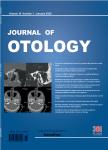Suprathreshold compound action potential amplitude as a measure of auditory function in cochlear implant users
Suprathreshold compound action potential amplitude as a measure of auditory function in cochlear implant users作者机构:Department of Communication Sciences and DisordersUniversity of Iowa Department of Communication Sciences and DisordersMontclair State University
出 版 物:《Journal of Otology》 (中华耳科学杂志(英文版))
年 卷 期:2017年第12卷第1期
页 面:18-28页
核心收录:
学科分类:1003[医学-口腔医学] 1002[医学-临床医学] 100213[医学-耳鼻咽喉科学] 10[医学]
基 金:supported by the National Institutes of Health, National Institute on Deafness and Other Communication Disorders under the following grants awarded to the University of Iowa: F31DC013202, P50DC000242, and R01DC012082 funded in part by the University of Iowa Department of Communication Sciences and Disorders
主 题:Cochlear implant Compound action potential Suprathreshold amplitude
摘 要:Electrically evoked compound action potential(e CAP) amplitudes elicited at suprathreshold levels were assessed as a measure of the effectiveness of cochlear implant(CI) stimulation. Twenty-one individuals participated; one was excluded due to facial stimulation during e CAP testing. For each participant, e CAPs were elicited with stimulation from seven electrodes near the upper limit of the individual s electrical dynamic range. A reduced-channel CI program was created using those same seven electrodes, and participants performed a vowel discrimination task. Consistent with previous reports, e CAP amplitudes varied across tested electrodes; the profiles were unique to each individual. In 6subjects(30%), e CAP amplitude variability was partially explained by the impedance of the recording electrode. The remaining amplitude variability within subjects, and the variability observed across subjects could not be explained by recording electrode impedance. This implies that other underlying factors, such as variations in neural status across the array, are responsible. Across-site mean e CAP amplitude was significantly correlated with vowel discrimination scores(r^2= 0.56). A single e CAP amplitude measured from the middle of the array was also significantly correlated with vowel discrimination, but the correlation was weaker(r^2= 0.37), though not statistically different from the acrosssite mean. Normalizing each e CAP amplitude by its associated recording electrode impedance did not improve the correlation with vowel discrimination(r^2= 0.52). Further work is needed to assess whether combining e CAP amplitude with other measures of the electrode-neural interface and/or with more central measures of auditory function provides a more complete picture of auditory function in CI recipients.



